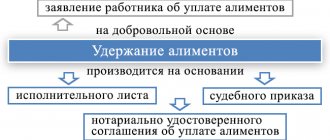Home/Amount of alimony/Amount of alimony based on average salary in 2020
If the payer of obligations to persons in need has received the status of “unemployed” at the Labor Exchange, or has inconsistent unofficial income, then when determining the amount of alimony, the court in 2020 takes into account the size of the average monthly salary in the Russian Federation. Data on the average income of Russian citizens is taken from the Rosstat website. On what basis alimony is calculated based on the average monthly salary in the Russian Federation and who is entitled to such payments in 2020 is described in detail below in the article.
Attention! If you have any questions, you can chat for free with a lawyer at the bottom of the screen or call Moscow; Saint Petersburg; Free call for all of Russia.
What is alimony based on average wages?
If one of the child’s parents (former spouses) is officially employed, that is, has a regular monthly income, then alimony is calculated in shares of earnings (clause 1 of Article 81 of the RF IC). However, it happens that the alimony worker loses his job. After which the dismissed citizen does not register with the Labor Exchange and, accordingly, does not receive unemployment benefits. In addition, it happens that the alimony worker has unofficial (irregular) income.
In the above cases, alimony is calculated based on the average salary in 2020 (clause “K” of the Decree of the Government of the Russian Federation No. 841 of July 18, 1996). Alimony debt is calculated on the basis of clause 4 of Art. 113 RF IC.
Alimony based on the average salary in 2020 is payments calculated based on data on the average Russian monthly income of workers in the Russian Federation . Such statistical information can be found on the Rosstat website.
About errors in calculations
All of the above indicators cannot be called even approximately accurate. There are several reasons for this:
- The territory of the state covers several climatic zones. In the northern regions, wages will always be higher than in warmer regions.
- Strongly expressed urbanization. In cities, the level of salaries and demand for specialists is several times higher than in villages.
- There is a significant gap between capital and regional salaries.
- Wages “in envelopes” are common. According to documents, an employee can receive one amount, but in fact receive another amount, and it can differ by 2-3 times.
Annual salary of doctors
As a result, for the same position and with the same responsibilities, an employee in one region can receive 60 thousand rubles, and in another - 15, or even lower. The gap is 4 times, the average figure is 37,500 rubles, which is far from reality for both the first and second employees.
For comparison: how much do citizens of other countries earn?
At the average dollar exchange rate for the first half of 2020, Russians receive about $550-600. Now here is a short list of average salaries in other countries:
- Ukraine - $100.
- India - $250.
- Moldova - $250-300.
- Georgia - $400-450.
- Bulgaria - $700.
- China - $750.
- Romania - $750-800.
- Czech Republic - $1400.
- Japan - $2000.
- Spain - $2200.
- Germany - $2500-2600.
- England - $2600.
- France - $2650-2700.
- Belgium - $2800.
- USA - $3300.
- Norway - $3700.
It turns out that in the global ranking, Russian salaries are much lower than the income level in developed Western countries. Even in the pre-crisis period, Russians received about $1,000 a month, which is still 2-2.5 times less.
On the other hand, in most of these countries the level of expenses differs significantly (taxes, utility bills, mandatory contributions to the Terms and Conditions of Compulsory Health Insurance, health insurance, cost of housing and various goods).
When is alimony paid based on the average salary in 2020?
When calculating alimony debt, in the absence of official information about the debtor’s salary, the judge (bailiff) calculates the amount of alimony based on the average salary of employees. Thus, alimony payments are calculated based on the average monthly earnings in Russia in 2020, only on the following grounds:
- If the payer has a child support debt. Moreover, the debtor’s income for the period of non-payment is not documented (clause 4 of Article 113 of the RF IC).
- When the person obligated for child support, who is the parent of the child, is not officially employed anywhere (Part 3 of Article 102 of Federal Law No. 229 of October 2, 2007).
- If the alimony debtor has not submitted documents on his income to the FSSP (clause 1.2 of the letter of the FSSP of the Russian Federation No. 00011/16/85969-AP dated September 15, 2016).
Attention:
If the alimony recipient went on a well-deserved rest and received a pension for himself, then the calculation of alimony is carried out based on the amount of the pension payment (clause 8 of the resolution of the Plenum of the Armed Forces of the Russian Federation No. dated December 26, 2020).
Benefits of paying average earnings obligations
For the collector of money, paying alimony calculated based on the average salary in the Russian Federation in 2020 has its advantages and disadvantages. The benefit of calculating alimony payments based on average income, in particular, can be considered that in some situations a financial amount is collected from the payer, more than what would be accrued as a share of his monthly earnings.
IMPORTANT
The disadvantage of calculating the alimony amount based on the average Russian salary in 2020 is the large difference between the monthly incomes of workers from different regions of the Russian Federation. Thus, according to data from the Rosstat website, in January 2020 the average earnings were equal to 46,674 rubles. However, in Chukotka the average salary was higher (105,132.80 rubles), and in the Ivanovo region, on the contrary, lower (26,415.80 rubles). As a result, the difference in wage levels between residents of the above regions amounted to such a significant amount: 78,717 rubles. (RUR 105,132.80 – RUR 26,415.80).
Table
| Yamalo-Nenetsky a. O. | 80876 |
| Moscow | 73846 |
| Magadan Region | 66821 |
| Magadan region+AO | 66344 |
| Sakhalin region | 65063 |
| Kamchatka Krai | 57637 |
| Kamchatka region + Yugra | 56605 |
| Tyumen region | 55990 |
| Saha Republic | 55628 |
| Saint Petersburg | 51024 |
| Murmansk region | 48328 |
| Khabarovsk region | 42525 |
| Moscow region | 42189 |
| Komi Republic | 41851 |
| Arhangelsk region | 39381 |
| Tyumen Region without Autonomous Okrug | 37303 |
| Arkhangelsk region without AO | 37094 |
| Leningrad region | 36140 |
| Krasnoyarsk region | 35886 |
| Tomsk region | 34634 |
| Primorsky Krai | 34439 |
| Irkutsk region | 33813 |
| Republic of Karelia | 33771 |
| Amur region | 33136 |
| Sverdlovsk region | 32854 |
| The Republic of Khakassia | 31841 |
| Jewish a.o. | 31605 |
| Vologda Region | 31217 |
| Transbaikal region | 31083 |
| Kaluga region | 30818 |
| Novosibirsk region | 30071 |
| Perm region | 29812 |
| Republic of Tatarstan | 29645 |
| Kemerovo region | 29590 |
| Chelyabinsk region | 29324 |
| Kaliningrad region | 29255 |
| Tula region | 28845 |
| Tyva Republic | 28632 |
| Nizhny Novgorod Region | 28424 |
| Krasnodar region | 28174 |
| Yaroslavl region | 27900 |
| The Republic of Buryatia | 27571 |
| Samara Region | 27172 |
| Bashkortostan | 26998 |
| Omsk region | 26693 |
| Belgorod region | 26590 |
| Ryazan Oblast | 26550 |
| Udmurt republic | 26457 |
| Astrakhan region | 26040 |
| Sevastopol | 26011 |
| Novgorod region | 25799 |
| Tver region | 25752 |
| Rostov region | 25750 |
| Volgograd region | 25546 |
| Vladimir region | 25369 |
| Voronezh region | 25287 |
| Orenburg region | 25229 |
| Lipetsk region | 25139 |
| Kursk region | 24823 |
| Smolensk region | 24591 |
| Altai Republic | 24093 |
| Ulyanovsk region | 24069 |
| Republic of Crimea | 24017 |
| Penza region | 23874 |
| Stavropol region | 23833 |
| Saratov region | 23133 |
| Chechen Republic | 22819 |
| Mari El Republic | 22764 |
| Bryansk region | 22706 |
| Kirov region | 22702 |
| Kurgan region | 22697 |
| Republic of Adygea | 22618 |
| Oryol Region | 22336 |
| Kostroma region | 22268 |
| North Ossetia Alania | 22080 |
| The Republic of Mordovia | 22078 |
| Chuvash Republic | 21975 |
| Tambov Region | 21441 |
| Pskov region | 21290 |
| The Republic of Ingushetia | 21078 |
| Republic of Kalmykia | 20999 |
| Ivanovo region | 20917 |
| Karachay-Cherkessia | 20844 |
| Kabardino-Balkaria | 20163 |
| Altai region | 20091 |
| The Republic of Dagestan | 19633 |
Who can receive alimony from the average salary in 2020?
Recipients of alimony based on the average salary in 2020 include minor children (Article 83 of the RF IC). When setting the amount of alimony, the court takes into account the current state of health of the payer of the obligations and the need of the child (Article 108 of the RF IC).
For your information
Once the children reach their 18th birthday, the parent's child support obligation ends. However, if the offspring is disabled, then the payment of alimony for children with disabilities from the average salary in 2020 continues on the basis of an agreement between the parents or a corresponding judicial act (clause 1 of Article 85 of the RF IC).
Determining the amount of alimony based on average wages in 2020
When determining the amount of alimony based on the average salary in the Russian Federation in 2020, the FSSP bailiff (judge) first opens the Rosstat website. Next, the official goes to the section “Labor Market, Population and Wages” and clarifies the average monthly income in Russia.
Moreover, according to clause 1.2 of the letter of the FSSP of the Russian Federation No. 00011/16/85969-AP dated September 15, 2020, personal income tax is not charged on the average salary in Russia. After all, such a statistical indicator is not the real income of the alimony worker.
IMPORTANT
According to paragraph 1 of Art. 81 of the RF IC, alimony for the average salary in 2020 is calculated in the following amount: for one child - 1/4 of the average monthly earnings (for two children - 1/3, and for three offspring, four or more children - 1/2 , respectively). Moreover, if a parent paid 1/4 of the alimony from the average income in Russia for the maintenance of a child from his first marriage, and then the obligated person began to have alimony obligations for his son (daughter) from his second marriage, then 1/6 is established for each minor offspring salary share (clause 1.2 of the letter of the FSSP of the Russian Federation No. 00011/16/85969-AP dated September 15, 2020).
Who can live well in Rus'?
Statistics clearly prove that the average salary level varies significantly depending on the type of activity. Rosstat regularly publishes a short report on the socio-economic situation in the country. His data says: the highest income is for a worker in the oil and gas industry engaged in “pipeline transportation” (the average monthly income in the first half of 2016 was 139,600 rubles).
The oil and gas and mining sectors are traditionally the most profitable. For your information, we offer a summary of the average monthly income of workers employed in the following areas (according to the first half of 2016):
- production of petroleum products - about 90,800 rubles;
- extraction of fuel and energy resources – more than 79,800 rubles;
- extraction of other minerals – over 51,400 rubles.
The ranking of other most profitable areas of activity, taking into account the average salary level, looks like this:
- financial sector - over 71,500 rubles;
- fish farming and fishing – 58,100 rubles;
- transport and communications – 42,200 rubles;
- production and distribution of gas, water, electricity - 40,300 rubles;
- manufacturing industries - 34,600 rubles;
- construction industry – 32,700;
- wholesale and retail trade – 29,700 rubles.
Healthcare workers receive an average of 28,600 rubles. The average salary of a doctor, according to Rosstat, is 35 – 50,000 rubles. taking into account specialization, and the approximate income of the head physician is 65,000. The minimum wage in the field of medicine and pharmaceuticals for laboratory assistants and nurses (14,000 and 19,000 rubles, respectively).
The average salary of education workers is 26,700 rubles. There is no significant difference depending on the profession, since the majority of specialists involved in this area are public sector employees. The minimum wage is for employees of preschool educational institutions, the maximum is for teachers of vocational education institutions.
A teacher's salary, contrary to popular belief, is not the lowest in the country. The lowest paid work is for workers in textile and clothing production (only 16,600 rubles). The incomes of agricultural workers, timber harvesters, waiters and administrators of restaurants and hotels are minimal. But the most important indicator is still the average income by region.
How to find out the amount of alimony based on the average salary in Russia as of the current date?
In order to find out the amount of alimony in 2020 based on the average salary in the Russian Federation as of the current date, the claimant needs to follow the following algorithm of actions:
- Go to the Rosstat website.
- Go to the “Statistics” section and select “Official Statistics”.
- Click on the subsection “Labor market, employment and wages”.
- On the right, select the item on average monthly real and nominal wages.
- Go to the sub-item on wages in general for the Russian economy for 1991-2020.
- Multiply the found average monthly salary by ½, 1/3, ¼ or 1/6 (depending on the number of child support recipients in the family).
In the regions of the Far North and nearby territories of the Russian Federation, a northern increasing coefficient is added to the employee’s basic salary. As a result, the average salary in 2020 in this area is high. In the south of Russia, earnings, on the contrary, are several times less.
IMPORTANT
As a result, when determining the amount of alimony based on the average salary in Russia in 2020, the average figure of average monthly earnings in the Russian Federation is established as a result of dividing the regional values of monthly income by 85 (by the number of constituent entities of the Russian Federation).
Where to go to study to earn more? Income table for Russian specialists
Obviously, the average temperature in a hospital is not very informative. From the point of view of making career decisions, it is much more important to know where they pay more in order to decide where to study. Therefore, we give approximate salaries for specialists in various specialties.
How many liters of gasoline can you buy with an average monthly salary in different countries?
We will take average figures for the country ( data taken from the resources Trud.com, Yandex.Work ):
| Speciality | Average salary in the Russian Federation, thousand rubles |
| Education | |
| Teachers in high school | 32 |
| Teachers at vocational schools | 29 |
| Kindergarten teachers | 26 |
| University teachers | 49 |
| Medicine | |
| Pediatrician | 40 |
| Dentist | 50-60 |
| Ship's doctor | 60 |
| Therapist | 40 |
| Urologist | 40 |
| Military doctor | 40-50 |
| Homeopathist | 45 |
| Gynecologist | 40-50 |
| Cosmetologist | 40-45 |
| Venereologist | 50 |
| Ultrasound diagnostician | 40 |
| Otolaryngologist | 45-48 |
| Surgeon | 45 |
| Nurse | 25 |
| Transport | |
| Taxi driver | 40-45 |
| Trucker | 50 |
| Passenger plane captain | 300 |
| Minibus and bus driver | 30 |
| Taxi dispatcher | 30 |
| Trolleybus driver | 30 |
| Subway driver | 45-50 |
| Train driver | 50-55 |
| Trolleybus conductor | 20 |
| Services sector | |
| Hairdresser | 30-35 |
| Visagiste | 30-35 |
| Manicurist | 30 |
| Waiter | 25 (“net” salary, without tips) |
| Cook | 35 |
| Administrator (hotel, inn, restaurant) | 30 |
| Masseur | 30 |
| Office | |
| Manager | 30-40 |
| Secretary | 30 |
| Accountant | 30-35 |
| Industry, blue-collar jobs | |
| Plumber | 30 |
| Electrician | 30-35 |
| Locksmith | 30 |
| Loader driver | 35 |
| Crane operator | 35-40 |
| Welder | 40 |
| Industrial climber | 40 |
| Chemical technologist (operator, operator) | 35-40 |
| Loader | 25-30 |
| Carpenter | 35 |
| CNC operator | 35-40 |
| Sales | |
| Cashier in a supermarket | 25-30 |
| Shop assistant | 25-30 |
| Merchandiser | 30-35 |
| Courier | 20 |
| Sales Representative | 30-35 |
| IT, Internet | |
| System Administrator | 40-45 |
| Web Designer | 35-40 |
| Content manager | 25-30 |
| Copywriter | 15-20 |
| SEO specialist | 25-30 |
| SMM specialist | 25-30 |
| Marketing, advertising | |
| Marketer | 30 |
| PR manager | 30 |
| Account Manager | 25-30 |
| Creative director | 40-45 |
| Promoter | 20-25 |
| Construction, renovation | |
| Handyman | 25 |
| Concrete worker | 25-30 |
| Painter | 30 |
| Mason | 30-35 |
| Foreman | 40-45 |
On the demand for specialties: who is missing in the country?
The labor market in Russia is unevenly distributed. In some areas there is an acute shortage of qualified specialists, in others there is a glut (there are many people with education and experience, but the demand for them is low).
This data is especially relevant for those who are planning to learn a new profession (both applicants and adults planning to change their qualifications).
The most in demand are such specialties:
- Cook. Any areas - from “confectionery” to specialization in some national cuisines. For highly specialized specialists (for example, in preparing dishes of some national cuisine), work can be found in larger cities. For general specialists - and in small towns.
- IT specialists. The most popular among them are 1C programmers, testers, content managers, copywriters, layout designers, and system administrators. A feature of the IT industry is the possibility of remote work (for most specialties).
- Office employees.
- Medical staff. In the healthcare sector, the shortage of personnel is probably felt most acutely. If there are still a lot of good programmers or engineers, then there are many times less qualified surgeons or neurologists, or even ten times less. There is also a shortage of medical personnel in other professions, primarily those with higher education. The shortage is most acute in villages and small towns: good specialists prefer to go to larger settlements, where there is also a great demand for them.
- Teachers. The shortage of teachers is primarily felt in secondary schools. To a lesser extent, the “staff shortage” is present in universities.
- Salespeople, cashiers. These specialties are among the lowest paid. The high demand is explained by “turnover”: if you pay attention, most supermarkets almost always have advertisements for personnel. Hence the high demand for employees.
- Construction specialties. There is high demand in large cities.
Average salaries and the Big Mac Index in different countries
Now let's give a more detailed list. We will separately indicate which specialties are in demand in small settlements (up to 100-150 thousand population, excluding “online” specialties):
- Salespeople, cashiers.
- Promoters.
- Managers (for cities).
- All medical specialties.
- “Narrow” industrial and blue-collar specialties (welders, carpenters, plumbers, electricians).
- Teachers.
In large cities (from 1 million) the following specialists are more often sought (excluding “online” specialties):
- All medical specialties.
- Teachers, tutors, nannies, educators.
- Managers, advertising specialists.
- Workers and construction specialties.
- Drivers.
- Salespeople, cashiers, couriers.
- System administrators.
- Cooks.
- Engineers.
And for some specialties, the demand is, on the contrary, small. This is mainly explained by the oversupply of specialists: there are many students studying in them, and the demand for workers in most cities is low. The list of such professions can include:
- Accountants.
- Lawyers.
- Designers.
- Economists.
- Psychologists.
- Officials.
- Cosmetologist.
- Vet.
An example of calculating average earnings in 2020
The amount of average monthly earnings for calculating alimony in 2020 is determined based on how many children the payer has. In addition, when establishing the alimony amount, the following period of time is taken into account: from the date a citizen receives the “unemployed” status at the Labor Exchange or is hired for an unofficial job, until the day the FSSP resolution is issued (clauses 2, 4 of Article 113 of the RF IC). For a complete understanding, you can refer to the example of calculating the average salary for alimony in 2020, presented below.
Example
In August 2020, Sidorov divorced his wife. On October 1, 2019, the man left his job and started working for the company unofficially (without formalizing an employment contract). Sidorov left behind a son aged 8 years.
On January 11, 2020, Sidorov received a resolution from the FSSP bailiff to calculate alimony arrears for the last 3 months (December, November and October 2020).
In December 2020, the average monthly earnings in the Russian Federation amounted to 62,239 rubles. As a result, the FSSP bailiff’s resolution indicated the following alimony amounts:
- October 2020 - RUB 15,559.75 (25% of RUR 62,239);
- November 2020 - RUB 15,559.75;
- December 2020 - RUB 15,559.75
When calculating alimony for Sidorov, the indicator “average monthly salary in the Russian Federation” was divided by ¼, which is 25%. After all, the divorced spouses have 1 common minor child.
Average for different specialties
Now we present the average salaries in 2020 for different specialties:
| Profession | Average salary in the Russian Federation, thousand rubles |
| Sales area | |
| Sales Representative | 33000 |
| Cashier | 26000 |
| Salesman | 26000 |
| Merchandiser | 33000 |
| Courier | 24000 |
| Administrator of the trading floor | 27000 |
| Construction sector | |
| Foreman | 43000 |
| Handyman | 24000 |
| Painter-plasterer | 30000 |
| Mason | 33000 |
| Concrete worker | 30000 |
| Crane operator | 40000 |
| Industry and blue-collar professions | |
| Welder | 40000 |
| Loader driver | 35000 |
| Driver of special equipment | 37000 |
| Electrician | 32000 |
| Plumber | 32000 |
| Locksmith | 30000 |
| Operator | 35000 |
| Loader | 25000 |
| Carpenter | 35000 |
| Office specialties | |
| Secretary | 30000 |
| Accountant | 33000 |
| Manager | 35000 |
| PR manager | 35000 |
| Marketer | 33000 |
| HR specialist | 33000 |
| Service sector, beauty | |
| Cosmetologist | 35000 |
| Visagiste | 33000 |
| Hairdresser | 33000 |
| Masseur | 33000 |
| Waiter | 25000 |
| Manicurist | 33000 |
| Cook | 35000 |
| Transport, logistics | |
| Driver | 27000 |
| Driver of a trolleybus, electric train | 32000 |
| Subway driver | 46000 |
| Train driver | 52000 |
| Taxi dispatcher | 30000 |
| Bus (minibus) driver | 30000 |
| Truck driver | 50000 |
| Truck driver | 35000 |
| Healthcare sector | |
| Nurse, caregiver | 25000 |
| Pediatrician | 37000 |
| Surgeon | 47000 |
| ENT | 45000 |
| Ultrasound specialist | 40000 |
| Venereologist, dermatologist | 50000 |
| Gynecologist | 45000 |
| Urologist | 40000 |
| Dentist | 50000 |
| Therapist | 40000 |
| The sphere of education | |
| High school teacher | 32000 |
| Teacher at school | 28000 |
| Teacher at the institute | 45000 |
| Kindergarten teacher | 26000 |
Collection of alimony obligations based on the average salary of the payer
The procedure for collecting alimony accrued based on the average salary in 2020 is as follows (Article 122 of the Code of Civil Procedure of the Russian Federation):
- The alimony recipient’s appeal to the magistrate’s court (clause 1 of the resolution of the Plenum of the Supreme Court of the Russian Federation No. dated December 26, 2020).
- Filing a claim. The rest of the necessary certificates are attached to the statement of claim.
- Court appearance.
- Receive a writ of execution and an extract from the court order (decision).
- Contact the territorial branch of the FSSP and submit an application to initiate new enforcement proceedings.
The following information is indicated in the lawsuit (Article 131 of the Code of Civil Procedure of the Russian Federation):
- name of the court;
- information about the claimant and the alimony payer (full name, registration, contacts);
- the amount of alimony and the requirement for its collection;
- Date of preparation;
- personal signature.
If a lawsuit is filed to recover alimony, the plaintiff does not pay the state duty (Part 2, Clause 1, Article 333.36 of the Tax Code of the Russian Federation).
The following documents are attached to the claim for the recovery of alimony based on the average salary in 2020:
- certificate of marriage (annulment);
- birth certificate of one child or several children;
- documents on the plaintiff’s work or lack thereof (from the Labor Exchange), as well as on the need to bear expenses for the maintenance of children (child);
- photocopies of the claim and documentation attached to the petition (according to the number of parties involved in the case).
The application to the FSSP to initiate new alimony enforcement proceedings shall include the following information:
- initials of the head of the Federal Bailiff Service of Russia for the region and his current position (“senior bailiff”);
- FULL NAME. claimant;
- personal information of the applicant (date of birth, registration, mobile phone);
- title (“Application”);
- the petition itself - “I ask you to accept for execution the writ of execution (No., date) in relation to the debtor (full full name). I ask you to transfer funds to: (bank account details)”;
- date of registration;
- personal signature.
A sample application to initiate enforcement proceedings is available.
A certificate of the alimony recipient’s personal bank account must be attached to the application to the FSSP to initiate new enforcement proceedings.
Calculation of alimony debt based on average earnings in 2020
In addition to the basic amount of the debt, the alimony debt for the average salary in the Russian Federation in 2020 also includes a penalty. The penalty is equal to 0.1% of the unpaid amount for each overdue day (Article 115 of the RF IC). Below is an example of calculating alimony debt based on average earnings in 2020.
Example
The former Reshetnikov spouses have been married since 2020. In 2016, a son was born into the family. In June 2020, the Reshetnikov couple divorced.
In June 2020, the mother of Reshetnikova’s child went to court. The defendant in the Reshetnikov case was unable to document his monthly income. As a result, alimony was calculated based on the average monthly earnings in the Russian Federation.
In June 2020, the average monthly salary in the Russian Federation was 49,348 rubles. The Reshetnikovs have one child together. Then the amount of alimony is 12,337 rubles. per month (RUB 49,348 × 0.25 (25%).
From July to October 2020, Reshetnikov allowed the formation of alimony debt. Moreover, the period of non-payment was 110 days.
The calculation of the alimony debt with penalties was made as follows:
- 12,337 rub./30 days = 411.23 rub. — alimony amount for child support (for 1 day).
- RUB 411.23 × 110 days of non-payment = 45,235.3 rubles. - the amount of the main alimony debt.
- RUB 45,235.3 × 0.001 (0.1%) = 45.24 rub. — late fee (for 1 day of delay).
- 45.24 rub. × 110 days of non-payment = 4,976.4 rubles. - penalty for the entire period of non-payment.
- 45,235.3 + 4,976.4 = 50,211.7 rub. - total to be paid by the alimony provider.
The FSSP bailiff must take into account that no more than 50% of the monthly income can be recovered from the alimony provider. This rule is established in Art. 138 Labor Code of the Russian Federation. In addition, in the event of collection of obligations to provide for minor children, no more than 70% of alimony can be withheld from the salary (the payer’s monthly income) (clause 3 of Article 99 of Federal Law No. 229 of October 2, 2007).
How can a debtor avoid calculating debt from average earnings in the Russian Federation?
To prevent money from being awarded based on averages, the following conditions must be met:
- official employment;
- declaration of all income;
- timely transfer of money to the child;
- eliminating debt.
If a parent pays money consistently and does not violate the established deadlines, then there will be no claims against him from the FSSP. If there are compelling reasons for temporarily stopping contributions or reducing the amount of alimony, you must go to court with a claim and supporting documents. Unauthorized termination of payment will be regarded as evasion of obligations, which entails the emergence of a debt.
Resolution on the calculation of alimony debt
The amount of alimony debt is indicated in the relevant decree of the bailiff (Article 102 of the Federal Law No. 229 of October 2, 2007). The document is drawn up within 3 calendar days from the date the FSSP employee receives the claimant’s application and the judicial act (clauses 7, 8 of Article 30 of the Federal Law No. 229 of October 2, 2007).
The resolution of the FSSP bailiff on the calculation of alimony debt specifies the following details:
- name of the FSSP of the Russian Federation (for example, Leninsky ROSP of the Russian Federation);
- address of the division of the FSSP of the Russian Federation;
- FULL NAME. bailiff;
- document details;
- FULL NAME. and registration of the alimony worker;
- FULL NAME. and registration of the claimant;
- subject of execution;
- amount of debt (As of “__”);
- period of non-payment;
- link to article 14, 102 Federal Law No. 229 of October 2, 2007 and Art. 113 RF IC;
- FULL NAME. and the address of the alimony payer and the claimant;
- surname and initials of the bailiff;
- FSSP seal.
The decision on the calculation of alimony debt can be appealed in court or to a higher authority of the FSSP. According to Art. 122 Federal Law No. 229 of October 2, 2007, the document can be appealed within 10 days from the date of registration.
Calculation of alimony based on average wages according to Rosstat
To calculate alimony from the average salary in 2020 according to Rosstat, the claimant needs to follow the following procedure:
- Go to the Rosstat website.
- Go to the “Statistics” section and click on the “Official Statistics” sub-item.
- Open the “Labor market, employment and wages” tab.
- On the right, open the sub-item “Average monthly accrued nominal and real wages of the organization’s employees.”
Below, for reference, is a table with the average salary in Russia over the last 5 years, that is, in the period 2015-2019. Data taken from the Rosstat website.
| Average monthly salary in Russia, according to Rosstat, rub. | 2015 | 2016 | 2017 | 2018 | 2019 |
| January | 30 929 | 32 660 | 34 422 | 39 017 | 42 263 |
| February | 31 325 | 33 873 | 35 497 | 40 443 | 43 062 |
| March | 32 642 | 35 501 | 37 899 | 42 364 | 46 324 |
| April | 34 377 | 36 497 | 39 225 | 43 381 | 48 030 |
| May | 34 380 | 37 270 | 39 679 | 44 076 | 47 926 |
| June | 35 395 | 38 447 | 41 454 | 45 848 | 49 348 |
| July | 33 901 | 35 888 | 38 073 | 42 413 | 46 509 |
| August | 32 176 | 35 405 | 37 099 | 41 364 | 44 961 |
| September | 32 911 | 35 843 | 38 047 | 41 774 | 45 541 |
| October | 33 357 | 35 749 | 38 333 | 42 332 | 46 549 |
| November | 33 347 | 36 195 | 38 848 | 42 595 | 46 285 |
| December | 43 408 | 47 554 | 51 197 | 55 569 | 62 239 |
For an example of calculating alimony from the average salary according to Rosstat, we can consider the following situation:
Example
The Ivanov couple got married in 2020. The following year their son was born.
In February 2020, the Ivanovs divorced. After the divorce, the ex-wife went to court. The child's father, Ivanov, did not provide any documentation confirming his monthly income.
The court decision to collect alimony was issued on February 11, 2020. In January 2020, the average Russian salary was 46,674 rubles.
The divorced Ivanov spouses have 1 common child (son). As a result, the court decision dated February 14, 2020 established the following amount of alimony: 46,674 × 0.25 (25%) = 11,661.75 rubles.
Arbitrage practice
As judicial practice shows, courts generally reject claims challenging the decision of the FSSP bailiff to collect alimony debt accrued based on the average salary in the Russian Federation.
An example from judicial practice
The Moscow City Court, in its appeal ruling No. 33-29006/2015 dated August 14, 2020, upheld the decision of the Zyuzinsky District Court of Moscow dated December 15, 2014. According to the verdict of the first court of December 15, 2014, the applicant was denied the claim to invalidate the decision of the FSSP bailiff on the basis of Art. 102 Federal Law No. 229 of October 2, 2007 and clause 5 of Art. 113 RF IC. During the court hearing, the Moscow City Court made sure that the calculation of alimony debt was carried out according to the law. After all, the alimony provider did not submit a 2-NDFL certificate to the FSSP for the period from May 5, 2005 to March 30, 2009, from July 1, 2010 to October 26, 2010. As a result, alimony was calculated based on average monthly earnings in the Russian Federation.
Similar cases from judicial practice are given in the appeal rulings of the Sverdlovsk Regional Court No. 33-6748/2015 dated May 20, 2020 and the Moscow City Court No. 33-25553 dated July 20, 2015.









